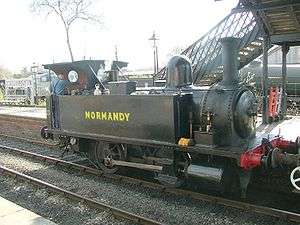LSWR B4 class
| LSWR B4 Class | |||||||||||||||||||||||||||||||||||
|---|---|---|---|---|---|---|---|---|---|---|---|---|---|---|---|---|---|---|---|---|---|---|---|---|---|---|---|---|---|---|---|---|---|---|---|
 Preserved Normandy on the Bluebell Railway. | |||||||||||||||||||||||||||||||||||
| |||||||||||||||||||||||||||||||||||
| |||||||||||||||||||||||||||||||||||
| |||||||||||||||||||||||||||||||||||
| |||||||||||||||||||||||||||||||||||

The London and South Western Railway B4 class is a class of 0-4-0T dock tank.
Construction
The London and South Western Railway's built twenty to a design by their Locomotive Superintendent William Adams at its Nine Elms Works during the 1891–1893 period. They were designed for shunting in locations with sharp curvature, and were used in places such as Southampton Docks (which the LSWR purchased in November 1892), the Poole Quay Line, and the Hamworthy Freight Branch.
Adams' successor, Dugald Drummond, designed and built a similar class of five in 1905, designating them the K14 class. However Drummond's successor considered them so similar, that they were merged in to the B4 class.
| Order | Year | Quantity | LSWR numbers | Notes |
|---|---|---|---|---|
| B4 | 1891 | 10 | 85–94 | |
| D6 | 1893 | 10 | 81, 95–100, 102, 103, 176 | |
| K14 | 1908 | 5 | 746, 747, 82–84 | 746/747 renumbered 101/147 in 1922 |
Many locomotives were used by Southampton Docks, who had a tradition of giving their locomotives names rather than numbers. Consequently, fourteen locomotives received names while in dock service:
| LSWR No. | Name |
|---|---|
| 85 | Alderney |
| 81 | Jersey |
| 86 | Havre |
| 89 | Trouville |
| 90 | Caen |
| 93 | St Malo |
| 95 | Honfleur |
| 96 | Normandy |
| 97 | Brittany |
| 98 | Cherbourg |
| 102 | Granville |
| 176 | Guernsey |
| 746 | Dinan |
| 747 | Dinard |
Service
The class were assigned to various depots around the LSWR system, including Southampton Docks, Eastleigh, Plymouth Friary, and Bournemouth. The Southern Railway also used them at Dover Marine, Ashford, Stewarts Lane and Guildford. They were also used to shunt the cramp goods yard at Winchester City railway station.
| Year | Quantity in service at start of year | Quantity withdrawn | Locomotive numbers | Notes |
|---|---|---|---|---|
| 1948 | 25 | 4 | 30090, 30091, 30101, 30176 | 30101 and 30176 sold |
| 1949 | 21 | 10 | 30081, 30085, 30092, 30095, 30097–30100, 30103, 30147 | All except 30085 sold |
| 1957 | 11 | 2 | 30082, 30094 | |
| 1958 | 9 | 1 | 30087 | |
| 1959 | 8 | 4 | 30083, 30084, 30086, 30088 | |
| 1960 | 4 | 1 | 30093 | |
| 1963 | 3 | 3 | 30089, 30096, 30102 | 30096 and 30102 sold |
Preservation
Two have survived into preservation:
- No. 96 (BR no. 30096) Normandy was sold to Corrall Limited and used at their Southhampton coal depot, where it was named Corrall Queen. It has been preserved on the Bluebell Railway, where in the days before it has any diesels, it was often used where other heritage railways used a diesel shunter. It is at present at the end of its boiler certificate and is on static display awaiting overhaul.
- No. 102 (BR no. 30102) Granville was purchased in 1964 after withdrawal by Butlins, and then put in display alongside LMS Royal Scot class 6100 Royal Scot at the firm's Skegness holiday camp. In 1971 it was moved to Bressingham Steam Museum near Diss, Norfolk, where it remains on display.[1]
References
- ↑ Stone 1999, p. 100.
- Stone, Colin (1999). Rails to Poole Harbour. Usk, Monmouthshire: Oakwood Press. ISBN 0-85361-553-5.
External links
| Wikimedia Commons has media related to LSWR B4 class. |